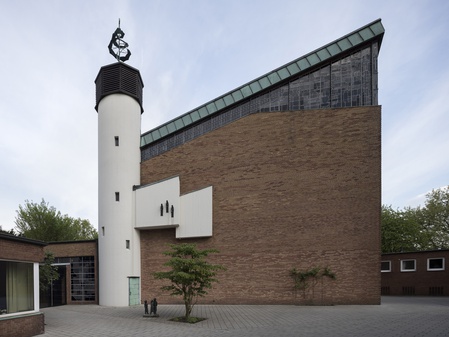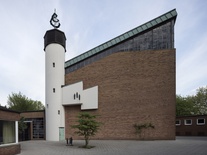Cerith Wyn Evans

A Modified Threshold … (for Münster) Existing church bells made to ring at a (slightly) higher pitch
A Modified Threshold … (for Münster) Existing church bells made to ring at a (slightly) higher pitch
2017
Installation
Bells of the St Stephanus Church, refrigeration unit
Location
St Stephanus Church, Stephanuskirchplatz 4
bell-ringing 8 am, 12 noon, 4, 7 pm
Temporary Installation for the duration of the exhibition
Cerith Wyn Evans
* 1958 in Llanelli, Wales
lives in London, United Kingdom
A mixture of conceptual, philosophical, and poetic ideas serves as the basis for Cerith Wyn Evans’s works. The concurrence of these somewhat contradictory readings is made possible by the use of reduced means, such as light, sound, and the written word, and a minimalist aesthetic whose overall timbre is rather cool. In addition to that, great importance is attached to the particular context of each installation and exhibition which offers further frames of reference in terms of form and content. Some of Wyn Evans’s works literally deal with the extremes of all or nothing: they lend themselves as a projection screen for profound and all-encompassing ideas devoid of any opulence — thus approximating nothing.
In the belfry of the Brutalist-style St Stephanus Church in the Aaseestadt district of Münster, Wyn Evans installed an air-conditioning unit that cools the bells. With the change in temperature, the bells rang at a higher pitch – although this is hardly perceptible to the human ear.
Münster has a high density of churches, and the interplay of ringing bells resounds across the entire city. From the beginning, Wyn Evans pursued the idea of not adding another sculpture to the cityscape. Instead, he saw his project as a means rather to remove something. After deciding to subtly manipulate the omnipresent sound of the bells, he selected the churchyard of St Stephen’s. Built by the Cologne architect Hans Schilling in 1965, this was the first new church to be built in Münster after the Second Vatican Council. The spirit of optimism that prevailed at the time manifested itself in the ensemble’s daring architecture. The building’s specific quality and the visible traces of active congregational life make the church a lively place, which emerges as an important dimension of the work owing to the installations’ reduced means.
Jan Bockholt
Location
- Still existing / Public Collection
- Removed
- In the museum
